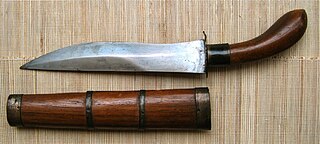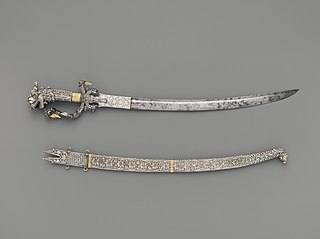This is a list of types of swords.

The kris, or keris in the Indonesian languages, is an Indonesian asymmetrical dagger, both weapon and spiritual object, with distinctive blade-patterning achieved through alternating laminations of iron and nickelous iron (pamor). Of Javanese origin, the kris is famous for its distinctive wavy blade, although many have straight blades as well, and is one of the weapons commonly used in the pencak silat martial art, native to Indonesia.

Seax is an Old English word for "knife". In modern archaeology, the term seax is used specifically for a type of small sword, knife or dagger typical of the Germanic peoples of the Migration Period and the Early Middle Ages, especially the Saxons, whose name derives from the weapon. These vary considerably in size.

The shashka or shasqua is a kind of sabre; a single-edged, single-handed, and guardless backsword. The comparatively subtle curve of a shashka blade puts the weapon midway between a typically curved sabre and a straight sword, effective for both cutting and thrusting.

A kalis is a type of Philippine sword. The kalis has a double-edged blade, which is commonly straight from the tip but wavy near the handle. Kalis exists in several variants, either with a fully straight or fully wavy blade. It is similar to the Javanese keris, but differs in that the kalis is a sword, not a dagger. It is much larger than the keris and has a straight or slightly curved hilt, making it a primarily heavy slashing weapon.

The gunong is a knife from Mindanao and the Visayas islands of the Philippines. In ancient past, it was called bunong by the Tagalog people. It is essentially a diminutive form of the larger kalis or kris. The gunong serves both as a utility knife and as a thrusting weapon used for close quarter fighting—usually as a last defense. It is most often associated with the Maranao, among whom the gunong was traditionally carried by both sexes, although it exists in other cultures throughout Mindanao and the Visayas. The weapon is generally tucked into the back of a waist sash.

A kasthane is a short traditional ceremonial or decorative single-edged Sri Lankan sword. The sword is featured in the Flag of Sri Lanka.

Jimpul is a traditional weapon of the Sea Dayak and Kenyah people from Borneo. It is often thought that the Parang Jimpul may be considered as a hybrid between the Mandau and Langgai Tinggang. The Parang Jimpul is an intermediary form between the Mandau and the Langgai Tinggang dating from c. 1870-c. 1885.

Balato is a sword that originates from Nias, an island off the west coast of North Sumatra, Indonesia.

Sewar refers to a dagger of Indonesian origin, typically carried in a belt and used mainly in Sumatra, Indonesia. The blade is also referred to as Sewah by the Gayo people, Seiva by the Minangkabau people, Siva by the Alas people, and Siwaih by the Acehnese people.

Palitai is the traditional knife of the Mentawai people, originating from the Mentawai Islands off West Sumatra, Indonesia.

Kabeala is a traditional weapon originating from East Sumba, Indonesia.

Wedung is a traditional large knife of the Javanese people and the Balinese people originating from Indonesia.

Gari is a sword that originates from Nias, an island off the west coast of North Sumatra, Indonesia. It is a term used for a type of sword found only in North Nias.

Alamang or Sonri is a sacred sword or cutlass of the Bugis and Makassarese people in Sulawesi, Indonesia.

Nias people are an ethnic group native to Nias, an island off the west coast of North Sumatra, Indonesia. In the Nias language, the Nias people are known as Ono Niha, which literally means 'descendants of human'. Nias island is known as Tanö Niha, with Tanö meaning 'land' in the Nias language.

Pisau raut is a whittling knife that is commonly as a tool to prepare the rattan and other fine carving found throughout the entire Malay archipelago. It is well known as an accompanying knife placed in the same sheath with the mandau, a traditional weapon of the Dayak people.

The Piso Sanalenggam is a type of broad sabre from North Sumatra, Indonesia. This sword is a weapon of war during the times when feuds were frequent among the different Batak groups. Piso Sanalenggam that were made by datu priests from the Dairi Regency region, is used for the preparation of medicine and magical substances.

The Dohong is a dagger or short war sword from Borneo. The name is used figuratively to imply bravery. In other parts of Borneo, it is simply referred to as Mandau. The Dohong is considered an ancient Dayak sword that was used long before the Mandau was introduced. It is believed to be the oldest weapon of the Dayak people. According to folklore, the first people who owns the Dohong are the forefathers of Dayak people, namely Raja Sangen, Raja Sangiang, and Raja Bunu.

Tumbok Lada or Tumbuk Lada is a traditional slightly curved dagger that originates in the eastern coast of Sumatra, Indonesia but also found in the western coast of Malay Peninsula, Malaysia.






















